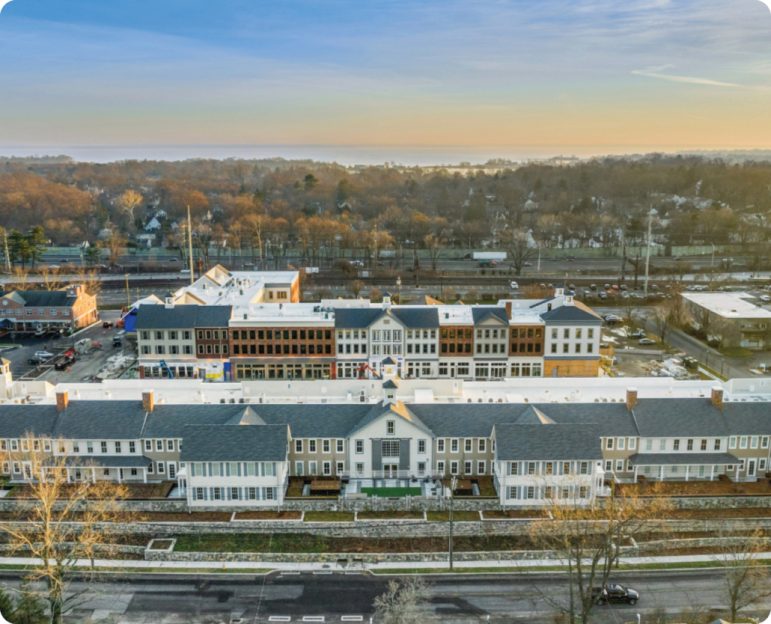It’s the buzzword du jour in Hartford these days: TOD, or Transit Oriented Development. What it implies and how it’s implemented aren’t always the same.
The idea is to put new, denser housing near train and bus stations, encouraging folks to drive less by being able to walk from their homes to mass transit, taking them to and from their jobs. An admirable enough goal in a state that’s failing to get its war on global warming underway.

Image from Federal Realty
The main entrance to Darien Commons, across Heights Road from Noroton Heights train station.
But just plopping housing, affordable or luxury, near a train station doesn’t mean people will want to live there if the only amenity is a short walk to transportation. So how is TOD done right? Look no further than Darien Commons, the 9-acre complex across from the Noroton Heights train station, opened in 2022.
Developed by Federal Realty, a REIT with more than 100 properties totaling 26 million square feet, the mixed use development shows the evolution of such projects. When it began in 1962, Federal specialized in outdoor shopping centers with grocery stores as the main (anchor) tenants. But starting around 2000 the company pivoted, adding housing above the retail stores, still in an outdoor, walkable environment.

Photo from Federal Realty
Aerial view of Darien Commons, looking south across the train tracks and to Long Island Sound.
“It was fundamental to our planning to place new developments near train stations,” says Patrick McMahon, senior vice president of Federal who oversaw the Darien project. “But TOD is more than just building apartments,” he adds. “It’s about designing a community.”
So Darien Commons has 122 apartments and 75,000 square feet of retail space. Federal had a specific strategy of mixing stores answering daily needs (food, banking, exercise) with upscale incidentals (pet store, restaurants, nail salons). It’s like its own village: everything you need is in the complex and your trip to and from your job starts right across the street.
That’s resulted in greatly reduced car ownership for the tenants: just 140 cars for 122 apartments in a town with 17,000 registered cars for a population of 22,000 (32% under age 18). Mind you, the apartments are not cheap. According to Trulia, the few available one bedrooms start at $3,500 per month and two bedrooms at $4,600. But under the town’s inclusionary zoning policy, 14 of the units are “affordable” ($1,600 per month).
Questions
But with work-from-home and reduced daily commuting, does TOD still make sense? McMahon says yes.
“Most of our tenants are still catching the train two or three days a week,” he says, even though they’ve added “Zoom Rooms” (small conference rooms) to their mix of tenant amenities. Those also include a private patio with BBQ grills, a party room, gym and a bookable hotel room for visiting guests.
Maybe there’s a lesson here for the housing zealots eyeing TOD as the solution for the state’s housing, especially along the Shore Line East rail line where CDOT still seems opposed to restoring train service.
Will developers really want to invest in new housing near train stations if they don’t offer adequate rail service? And without TOD, will demand for trains ever come back?
____________________

Contributed photo
Jim Cameron
Jim Cameron has been a Darien resident for more than 25 years. He is the founder of the Commuter Action Group, sits on the Merritt Parkway Conservancy board and also serves on the Darien RTM and as program director for Darien TV79. You can reach him at CommuterActionGroup@gmail.com.
